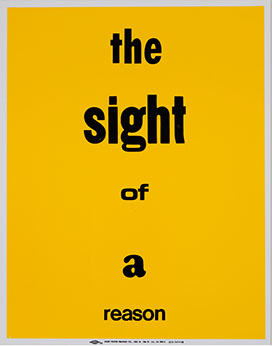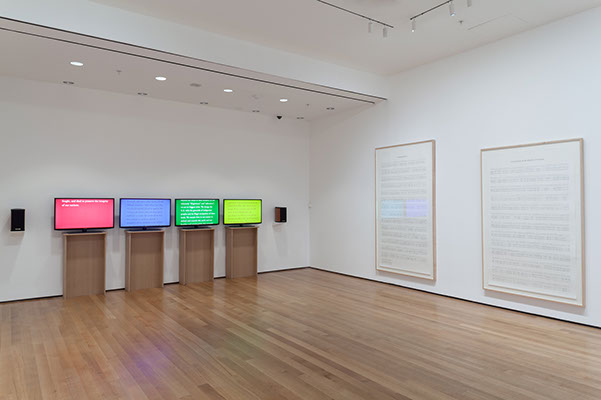

Installation view of Sites of Reason: A Selection of Recent Acquisitions, The Museum of Modern Art, June 11–September 28, 2014. © 2014 The Museum of Modern Art, New York. Photograph: Thomas Griesel
The title of the Museum of Modern Art’s recent exhibition Sites of Reason is an intended misquotation of Gertrude Stein’s Tender Buttons (1914), “The sight of a reason, the same sight slighter, the sight of a simpler negative answer, the same sore sounder, the intention to wishing, the same splendor, the same furniture.” A masterpiece of Modernist literature, Tender Buttons explores and undermines the relationship between our experiences and the objects that shape them, the motivations that drive them, and the language to communicate them. Curator David Platzker has taken Stein’s experimental syntax as inspiration, and the resultant selection of works is one that questions language as a system through side-eyed immersion.
The exhibition begins in the outside hallway with Eve Fowler’s A Spectacle and Nothing Strange (2011-Present), a set of 21 letterpress printed posters with quotations from both Tender Buttons and Stein’s How To Write (1931). Originally hung around the streets of L.A., the snippets are alternately fun—Rub Her Coke—and clouded—Very Different But Much More. Printed in neon rainbow rolls, the feeling is that of simultaneous shouts and whispers, enthusiasm and reproach. This inner voice materializes as you approach the gallery, with Richard Serra and Nancy Holt’s multimedia pioneering work Boomerang. Holt appears on screen, as she did on a local Texas television station in 1974, wearing antennaed headphones, in a microphoned studio where her own voice is looped back, with about a half-second delay. The viewer can hear both her initial statements and the echo while she talks through the experience, noting the increasing disassociation between herself and her words, “There is no escape and it is constantly evolving.” Incredibly meta, this video as well as Fowler’s posters function as introductory manuals for how to approach the remaining work, which is spread across a spectrum of conceptual and experiential.
Eve Fowler. A Spectacle and Nothing Strange. 2011-ongoing. 21 letterpress posters. 28 x 22” (71.1 cm x 55.9 cm) each. The Museum of Modern Art Library. © 2014 Eve Fowler

The overall feeling of the exhibition space is beige, black, and dry, most of the work consisting of minimalist text on simple substrate. All require reading of some kind, often at a gallery-safe distance, with low foot-candle. The prime example is Allen Ruppersberg’s The Picture of Dorian Gray (1974), which impedes understanding through its own existence. Ruppersberg diligently wrote out Oscar Wilde’s entire eponymous text over 20 five-foot square canvases and presents them unhung against the wall. Some are stacked on top of the other, so even if you had the hours and willpower to read the whole novel, it would be impossible. Perhaps through this willful impossibility of conventional understanding—reading text word-by-word, line-by-line—Ruppersberg asks for other, alternative intelligibilities.

Installation view of Sites of Reason: A Selection of Recent Acquisitions, The Museum of Modern Art, June 11–September 28, 2014. © 2014 The Museum of Modern Art, New York. Photograph: Thomas Griesel
Evolving disassociation and convergences of syntax and meaning pulse throughout, particularly in Matt Mullican’s overlarge maze Untitled (Learning from That Person’s Work: Room 1) (2005). Accompanying wall text premises, “Since 1977, Mullican has been working under hypnosis, which he considers a way of breaking the patterns of everyday life…In this altered state, Mullican becomes someone he refers to as ‘that person’: an ageless, genderless being that is a passenger inhabiting his body.” Panels of cotton sheets are stretched between approximately seven-foot high wooden poles, populated by grocery lists, number sequences, and a strained, strange intimacy with a faceless other. Also present is an old school television on the floor in a corner, which shows a loop of a draining bathtub, over which we hear Mullican, allegedly as “that person”, mumbling incoherently along with the gurgling of the water. The work is a peephole into another’s internal life, crashing up against its own barriers, once removed through a sustained technique of hypnosis.
The other work in the gallery, including Hanne Darboven, Simryn Gill, Liz Deschenes, and Emily Roysdon, among others, seems to ripple outwards and answer back to Mullican’s Freudian splash and Ruppersberg’s painstaking grandstand. Where all of this work leaves us, as viewers, is in a slow circumambulation, from one site to another. The motivations for understanding diverge and reappear, the physicality of each piece teasing us to get it. When legible, the text incorporated into each work seems to bubble with secrets, promises of alternate realities. What every work in the exhibition says explicitly, however, is try again, come back. Once is not enough.
Sites of Reason is a challenging exegesis on a cliché Post-Modernist lesson, which Stein was working on a century ago; meanings, as prescribed by language, are neither stable nor permanent. Most importantly, they are always user-driven, and can be dismantled or created as we go along.

Charles Gaines. Manifestos 2. 2013. Four-channel video and four graphite drawings on Rising Barrier Paper. Overall dimensions variable. Acquired through the generosity of Jill Kraus, Jerry Speyer and Katherine Farley. © 2014 Charles Gaines. Photograph © 2014 The Museum of Modern Art, New York. Photograph: Thomas Griesel
The Museum of Modern Art
11 West 53 Street
New York, NY 10019-5497
(212) 708-9400
From the Website:
The title of this exhibition is adapted from the phrase “the sight of a reason,” a line in Gertrude Stein's groundbreaking prose work Tender Buttons (1914). In her collection of “portraits” of everyday phenomena, Stein employed experimental syntax to free language from established usage and to “create a word relationship between the word and the things seen.” Sites of Reason: A Selection of Recent Acquisitions begins with an ongoing work by the Los Angeles–based artist Eve Fowler (American, b. 1964), which appropriates phrases from Tender Buttons and Stein's How to Write (1931) in commercially printed posters originally intended for public display—for instance, stapled to telephone poles or fences. Stein’s probing of the correlation between language and the physical world—and Fowler’s act of recontextualization—exemplify a set of concerns shared by the works presented here.
The exhibition brings together recently acquired works by two generations of contemporary artists, including Sol LeWitt, Richard Serra with Nancy Holt, Allen Ruppersberg, Seth Price, Simryn Gill, Liz Deschenes, Charles Gaines, Emily Roysdon, Matt Mullican, Hanne Darboven, and Peter Downsbrough. These works engage subtle visual vocabularies to consider image, text, gesture, voice—and hybrids of these—as sites of exchange between aesthetic, ideological, and social systems. As processes of visual and narrative reading coalesce, questions emerge about the assumed role of the artist as singular author and how the migration of information across a range of forms multiplies, or dissolves, its meaning.
Disclaimer: All views and opinions expressed are those of the authors and do not necessarily reflect the views of the editors, owner, advertisers, other writers or anyone else associated with PAINTING IS DEAD.
